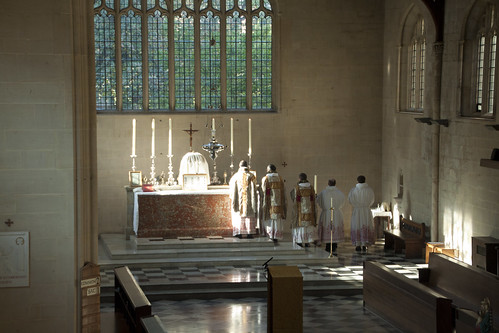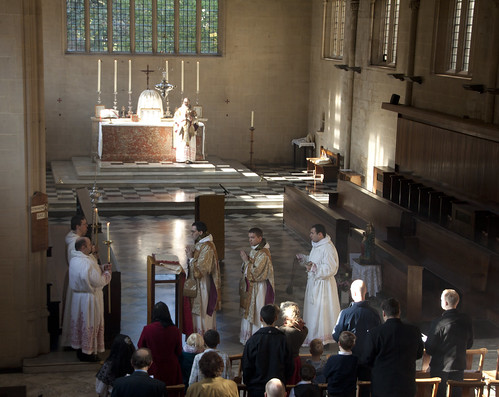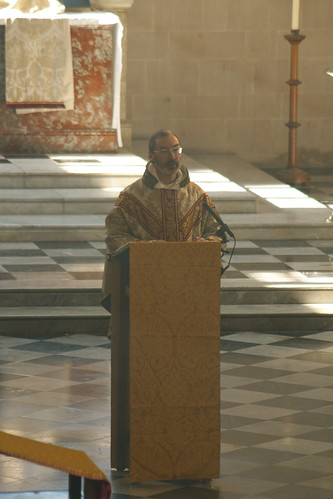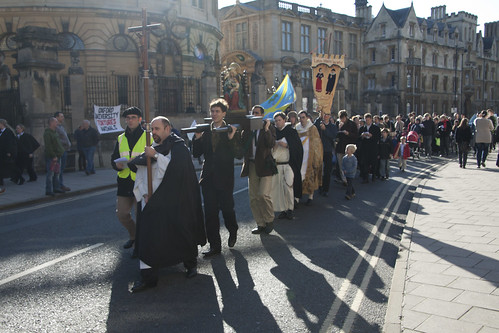Dear friends.
In today’s Gospel we find two opposite attitudes. On the one hand Jesus points out the hypocrisy of the scribes and the Pharisees, those who lay heavy burdens on the people’s shoulders without lifting a finger themselves. On the other hand, Jesus explains us what attitude we should have: ‘The greatest among you shall be your servant’. Now, what do these two attitudes have in common? Nothing, at first glance. The former addresses what is corrupt: the search for elevation and honour, but it is built on a lie. It is a lie, because a hypocrite gives the impression of having virtues that he or she in fact neglects to fulfil. But the second attitude, about being a servant, is built on truth and humility, the one who willingly puts others first in order to help and who carries the burdens with others and for others. The two attitudes are direct opposites of each other.
It is not a coincidence that Jesus puts humility up against pride, the humble servant up against the hypocrite. What is the purpose of this? Is it a moral question? Is it Jesus demanding us to have the attitude of a servant, just as Jesus serves us? I don’t know about you, but I think I would get exhausted quite quickly if that were the only and ultimate goal. I think we would run dry quickly trying live the life of a servant for its own sake. It’s not about running after humility for humility’s own sake, nor self sacrifice for self sacrifice’s sake. These are all important values, but Jesus explains to us that they all stand in service of a very precise aim, -that is friendship. Or, as Jesus tells us in the Gospel of John: I don’t call you servants, but friends (John 15,15).
There may be sacrifices, but always for the sake of friendship: ‘Greater love has no one than this, that he lay down his life for his friends’ (John 15,13). For friends. The whole project of salvation has as its ultimate purpose to recreate full friendship between humanity and God, and among men.
And this is where the two attitudes that we have pointed out will converge. Both humility and hypocrisy has all to do with friendship. The biggest problem with hypocrisy is not simply the immorality of it in itself, or the lies it tries to cover. The biggest problem is that as it is built on a lie, it makes it impossible to construct real friendship. The means of open communication are blocked, and so also the friendship that God wants to offer. Humility, on the other hand, is nothing but a silent ‘yes’ to God’s friendship. It is the open-hearted, open-minded attitude towards the other. Celebrating the mysteries is to celebrate God’s infinite friendship towards us.
But didn’t Jesus tell us to serve him, and serve the world? Are we not called to be God’s servants? Well. What is the difference between friendship and serving? We may discover the difference by applying the word duty. A friend doesn’t serve out of duty. If I get a visit from a friend when I’m lying ill in bed, the reason why it feels so good is exactly because this person didn’t do it out of duty. He did it out friendship. Jesus did not go the way of the Cross out of duty. He did it out of infinite love, out of the desire of friendship with the whole human race. It is this desire that Jesus wants to share with us. When Jesus talks about who is the greatest among us, he really talks about who is the greatest friend! This is what true greatness is about. And the greater a friend, the more unselfish he or she will be. This is the Christian vocation. We are called to be friends. And that goes beyond the comfy-zone of our daily life. We are talking about an attitude, a way of meeting all people, from family members to colleagues to those living on the street. There is none who do not deserve to be met as equal human beings.
This kind of true friendship is not first and foremost about giving advice and help, showing sympathy or giving comfort. It is rather to give oneself. To be a friend means that I am myself for another person, without pulling back, without trying to hide. It is to take initiative without demanding any guaranties. For these reasons, it can be a temptation to replace friendship with friendliness. It’s nothing wrong in being friendly, but we need to be aware of the difference between this and the Christian vocation. Anyone can be friendly. I’m sure that the devil, in arguing with Jesus after his stay in the desert, was quite friendly, maybe even charming. But was he a friend? And maybe Jesus wasn’t always friendly in the sense of always wanting to charm, but he never rejected anybody who truly sought him. He never does, he remains faithful.
Friendship is not something particular to Christianity, the whole world praises true friendship. Still, as religion, Christ’s Gospel stands out as it makes friendship the heart of life, the absolute to which all else is relative. This is the heart of the Christian revolution. Christianity is the religion of friendship. Let us then, friends, be nourished by this mystery, as we receive our friend, The Son of God, in the humble form of the Eucharistic banquet.



 The Latin Mass Society made their annual pilgrimage to Oxford on the 22nd October, to commemorate the Martyrs of the City. Mass was celebrated in the Dominican Rite. The celebrant was Fr Richard Conrad OP, the deacon Fr Thomas Crean OP, and subdeacon Br Gregory Pearson OP. The Mass was served by Dominican students.
The Latin Mass Society made their annual pilgrimage to Oxford on the 22nd October, to commemorate the Martyrs of the City. Mass was celebrated in the Dominican Rite. The celebrant was Fr Richard Conrad OP, the deacon Fr Thomas Crean OP, and subdeacon Br Gregory Pearson OP. The Mass was served by Dominican students.



 hen I grew up, the prayer of the Rosary was compulsory to all of us at home. My brother and my sisters were members of the Legion of Mary. So, I grew up very well used to the Rosary. But it had not yet a deep meaning in my life as it was kind of a humdrum prayer. I used to feel some warmth in my heart as I would be praying the Rosary but that would fade away as soon as I would have finished praying.
hen I grew up, the prayer of the Rosary was compulsory to all of us at home. My brother and my sisters were members of the Legion of Mary. So, I grew up very well used to the Rosary. But it had not yet a deep meaning in my life as it was kind of a humdrum prayer. I used to feel some warmth in my heart as I would be praying the Rosary but that would fade away as soon as I would have finished praying.  Traduttore – traditore (the translator is a traitor) runs the Italian play on words, and its own English translation already gives us an example of what it’s talking about: the English words don’t sound as similar as the Italian, and so the wordplay doesn’t work as well. The translator faces a huge challenge in trying to convey the fullness of the original text, and inevitably something has to be compromised: perhaps the translator will feel the need to sacrifice the conciseness of the original, for example, in order to make the text more intelligible, or perhaps the importance of preserving the poetic form will be placed above the exact literal meaning of the words.
Traduttore – traditore (the translator is a traitor) runs the Italian play on words, and its own English translation already gives us an example of what it’s talking about: the English words don’t sound as similar as the Italian, and so the wordplay doesn’t work as well. The translator faces a huge challenge in trying to convey the fullness of the original text, and inevitably something has to be compromised: perhaps the translator will feel the need to sacrifice the conciseness of the original, for example, in order to make the text more intelligible, or perhaps the importance of preserving the poetic form will be placed above the exact literal meaning of the words.
 Blackfriars was once again honoured to host the
Blackfriars was once again honoured to host the 







 The academic year at Blackfriars began with a votive Mass of the Holy Spirit and Vespers. It is very apt to begin the year by asking the Holy Spirit, to fill us with wisdom and understanding, to enlighten our minds and to aid our studies in the year to come. It is also a good opportunity for the new students to meet each other and the friars. In his homily, the Regent of Studies, Fr. Richard Finn encouraged the congregation to allow the Holy Spirit to enflame their hearts and minds with a love of study and love of each other.
The academic year at Blackfriars began with a votive Mass of the Holy Spirit and Vespers. It is very apt to begin the year by asking the Holy Spirit, to fill us with wisdom and understanding, to enlighten our minds and to aid our studies in the year to come. It is also a good opportunity for the new students to meet each other and the friars. In his homily, the Regent of Studies, Fr. Richard Finn encouraged the congregation to allow the Holy Spirit to enflame their hearts and minds with a love of study and love of each other.













